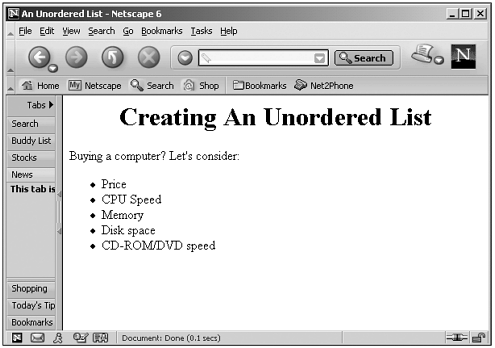The UL Element: Unordered Lists
The <UL> Element: Unordered ListsYou use the <UL> element to create unordered lists that usually have some visual element, such as a bullet in front of every item. Here's an example: (Listing 14-07.html on the web site)<HTML> <HEAD> <TITLE> An Unordered List </TITLE> </HEAD> <BODY> <H1> Creating An Unordered List </H1> Buying a computer? Let's consider: <UL> <LI> Price <LI> CPU Speed <LI> Memory <LI> Disk space <LI> CD-ROM/DVD speed </UL> </BODY> </HTML> You can see this page in Figure 14.3. Figure 14.3. Using an unordered list. You can find the JavaScript properties for the <UL> element in Table 14.4. Remember that JavaScript's core HTML properties, methods , and events, which we covered in Chapters 5 and 6, apply to this element as well. Table 14.4. The Properties of the <UL> Element (See Chapters 5 and 6 for the JavaScript core HTML properties, methods, and events that also apply to this element.)
| |||||||||||||||||||||||||||||||||||||||||||||||||||||||||||||||||||||||||||||
